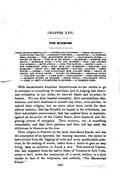
[p. 520]
CHAPTER XXII.
THE MORMONS
THEIR BEASTLY SENSUALITY—UNDENIABLE INDUSTRY—THEIR RELIGION— BARE–FACED FRAUDS—IGNORANT CONVERTS—JOE SMITH—A THEIVING WELL–DIGGER—"THE MANUSCRIPT FOUND"—SPAULDING'S NOVEL— STOLEN BY SMITH—USES IT AS HIS BIBLE—EXAMPLES—THEIVES AND THUGS—HORRIBLE RITE8—LUST AND MURDER—HOW THE CHURCH WAS FORMED—REVELATIONS—JOHN THE BAPTlST—SMITH'S BANK— THE PERMANENT ZION—WAX RICH AND NUMEROUS—ENRAGED MISSOURIANS —DRIVE OUT THE MORMONS—NAUVOO, ILLINOIS—THEIR POWER—CRIMES—THE lLLINOISANS RISE AGIANST THEM—DEATH OF JOSEPH AND HYRUM SMITH—FLIGHT TO NEBRASKA—BRIGHAM YOUNG —THE NEW LEADER—A NEW ZION—THE DANITES—FIRST ORGANIZED —THE MORMON SYSTEM OF MURDER—THEIR TOOLS—FILLMORE’S FOLLY —JOHN D. LEE'S ACCOMPLICES IN MURDER—A TERRIBLE DEED
With characteristic American impulsiveness we are certain to go to extremes in everything we undertake, and in judging this abnormal civilization in our midst, we have all blame and no praise to bestow. We see their beastial sensuality, their unrepublican clannishness, and their readiness to commit any crime, even murder, to uphold their religion, but we never allow them credit for their patient industry, that has founded an empire in the wilderness, nor their indomitable perseverance, that has enabled them to maintain, against all the power of the United States, their depraved and disgusting custom of polygamy. Their economy, too, is something remarkable, and that, their patience and their toil has made the wilderness to blossom as the rose.
Their religion is founded on the most bare-faced frauds, and was the conception of an ignorant, but cunning imposter, who seems to have turned from the digging of wells and more questionable practices, to the making of creeds, rather from a desire to gain an easy living, than an ambition to found a sect. This shrewed Yankee, who had migrated from his native State of Vermont to New York, seems to have stolen the manuscript of a novel, written in a style similar to that of the scriptures, and entitled, "The Manuscript Found."
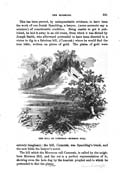
[p. 521]
This has been proved, by unimpeachable evidence, to have been the work of one Josiah Spaulding, a lawyer, (some accounts say a minister) of considerable erudition. Being unable to get it published, he laid it away in an old trunk, from which it was filched by Joseph Smith, who afterward pretended to have been directed in a vision to dig in a fabulous hill, (Cumorah) where he would find the true bible, written on plates of gold. The plates of gold were
The Hill of Cumorah—Morman Hill.
entirely imaginary; the hill, Cumorah, was Spaulding’s trunk, and the new bible the lawyer's novel.The hill which the Mormons call Cumorah, is called by the neighbors Mormon Hill, and the cut is a perfect representation of it, showing even the hole dug by the knavish prophet and in which he pretended to find the plates.
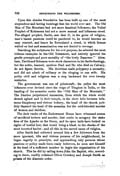
[p. 522]
Upon this slender foundation has been built up one of the most stupendous and lasting humbugs that the world ever saw. The Old Man of The Mountain had not more fanatical followers; the Veiled Prophet of Kohrassan had not a more sensual and infamous creed. The alleged prophet, Smith, saw that if, in the guise of religion, man’s basest passions could be pandered to, he would become an easy convert, and hence he formulated a creed, in which license waited on lust and assassination was not denied to revenge.
Searching the scriptures for his evil purpose, he selected the most hideous examples in the Old Testament, and entirely ignored the gentle precepts and pure morality of "the lowly Nazarene." Abraham, David and Solomon were stock characters in his facile theology, but the noble, learned, spotless Paul and He who died on Calvary, do not figure therein. His doctrines made polygamy a necessity, and did not admit of celibacy or the clinging to one wife. His polity civil and religious was a step backward for over twenty centuries.
The government was one of priestcraft; the police the most infamous ever devised since the reign of Thugism in lndia, or the banding of the assassins under the "Old Man of the Mountain." The Danites perpetrated massacres, from which the whole world shrank aghast and in their temple, in the short lulls between infamous blasphemy and riotous lechery, the head of the church publicly thanked the head of the assassins for the cold–blooded murder of women and children.
The dark vaults of the Endowment House have witnessed scenes of sacrificial torture and murder, that outdo in savagery the stake fires of the Apache or the Sioux, and its open halls have looked on sights of bestial lust, that would bring a blush to the cheeks of the most besotted harlot—and all this in the sacred name of religion.
After Smith had collected around him a few followers from the more ignorant, idle and vicious persons of his neighborhood, he began eagerly to proselyte, and approaching only persons whose passions or policy made them ready believers, he soon saw himself at the head of a suilicient number to begin the organization of his church. This he did by calling down John the Baptist, who, according to them, readily ordained Oliver Cowdery and Joseph Smith as priests of the Alamonic order.
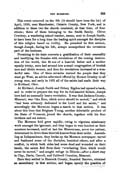
[p. 523]
This event occurred on the 6th (it should have been the lst) of April, 1830, near Manchester, Ontario County, New York, and in addition to these two the church consisted, at that time, of four others; three of them belonging to the Smith family. Oliver H Cowdery, a wandering school teacher, seems, next to Joseph Smith, to have been for a long time the leading spirit amongst the disciples of this religion based on virility. He preached its first sermon, though Joseph, during his life, always monopolized the revelation part of the business.
Promising to his male converts a gratification of their sensuality and terrifying the females with revelations of the coming destruction of the world, this fit son of a knavish father and a mother equally tricky, soon had around him a small congregation of brutish men and idiotic women, and then his revelations increased at a wonderful rate. One of these miracles warned the people that they must go West, an advice afterward offered by Horace Greeley to all I young men, and early in 1831 all of the saints had made their way to Kirtland, Ohio.
At Kirtland, Joseph Smith and Sidney Rigdon had opened a bank, and in order to prepare the way for its full—handed failure, Joseph here had an unusually heavy revelation. It was that Jackson County, Missouri, was "the Zion, which never should be moved," and which "had been solemnly dedicated to the Lord and his saints," and accordingly the Mormons began a march to that section. It was about this time that Brigham Young, another delectable product of the State of Vermont, joined the church, together with his four brothers and six sisters.
The Mormon fold, grew rapidly, owing to vigorous missionary work amongst the ignorant, and they began to wax insolent as their numbers increased, until at last the Missourians, never too patient, determined to drive these thievish knaves from their midst. Assembling at Independence, they broke up the Mormon newspaper, tarred and feathered some of the disciples, banished others, and after a conflict, in which both sides had some dead and wounded on their hands, the saints fled from their "everlasting Zion, which would never be moved," and sought refuge in Illinois—after a short stay in Clay, Davis, Carroll, and Caldwell Counties, Missouri.
Here they settled in Hancock County, founded Nauvoo, obtained
an ascendency in that section, and began openly the practice of
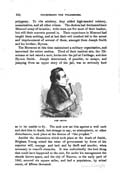
[p. 524]
polygamy. To vile adultery, they added high handed robbery,
assassination, and all other crimes. The cholera had decimated their
Missouri army of invasion; writs were out for most of their leaders,
but still their converts poured in. Their experience in Missouri had
taught them nothing, and at last their evil conduct led to the arrest
and imprisonment of several of them, amongst them Joseph Smith
and his brother, Hyrum.
The Mormons at this time maintained a military organization, and terrorized the entire section. Tired of their insolent airs, the Illinoisans at last raised a mob, broke into the jail at Carthage, and shot Hyrum Smith. Joseph determined, if possible, to escape, and jumping from an upper story of the jail, was so seriously hurt
Joe Smith.
as to be unable to fly. The mob now sat him against a well curb and shot him to death, but strange to say, no atmospheric, or other disturbances, took place at the demise of "the prophet."Amidst the dissensions which took place at the death of Smith, Brigham Young seized the reins of government by force of his superior will, courage and tact and by theft and murder, when necessary to remove obstacles. It was undoubtedly the best thing that could have happened to the sect, for under his management the church throve apace, and the city of Nauvoo, in the early part, of 1845, covered six square miles, and had a population, by actual count, of iifteen thousand.
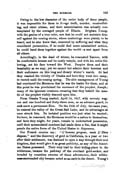
[p. 525]
Owing to the low character of the entire body of these people, it was impossible for them to forego theft, murder, counterfeiting, and other crimes, and their extermination was actually contemplated by the outraged people of Illinois. Brigham Young with the genius of a true ruler, saw that he could not maintain himself against the coming storm, whose mutterings were plainly to be heard, and he also knew that, cemented by suffering and what they considered persecution, if he could find some uninhabited section, he could band them together against the world—a sect apart from all others.
Accordingly, in the dead of winter, he evacuated Nauvoo, with its comfortable houses and its costly temple, and with his entire following, set his face toward the West. Despise them and their beastiality as we may, yet we cannot but admire their heroism and their endurance on this long and dreary winter’s march. At last they reached the vicinity of Omaha and here they went into camp, to recruit until the coming spring. The able management of Young had convinced the Mormons that he was the leader for them, and at this point he was proclaimed the successor of the prophet, Joseph; many of the ignorant creatures swearing that they beheld the mantle of the prophet visibly descend upon him.
From Omaha Young started, April 14, 1847, with seventy wagons and one hundred and forty—three men, as an advance guard, to seek anew a permanent Zion. On the 24th of July, the same year, he entered the valley of the Great Salt Lake, and its advantages at once struck him. Its isolated position was just what he wanted; for here, he reasoned, the Mormons would be a nation to themselves, and here they might, for years, remain in undisturbed possession, until their accumulated numbers had made them a foe, that it might puzzle the entire force of the United States to dispossess.
Our French cousins say: "L’homme propose, mais L’Dieu
diapose," and the discovery of gold in California, in a year or two
after their settlement, was destined to open a way through their new
kingdom, that would give it as great publicity, as any of the American
States possessed. Their very trail to their hiding—place in the
wilderness, became the pathway of the overland gold—seeker, and
invaded by countless swarms of these adventurers, their
wilderness—surrounded city became noted as an oasis in the desert. Young's
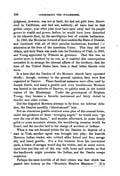
[p. 526]
judgment, however, was not at fault, for had not gold been discovered
in California, and had not, suddenly, all ways lead to that
golden center, year after year must have sped away and his people
grown to wealth and power, before he would have been disturbed
in his lakeside Zion, by the sacriligious feet of outside barbarians.
In 1849, the Mormons formed of their section the State of Deseret, and burdened with all of their peculiar institutions, knocked for admission at the door of the American Union. This they did not obtain, and their State was made into the Territory of Utah, in 1850, and Young appointed by Filmore as governor. That this was an unwise move is doubted by no one, as it enabled this unscrupulous sooundrel to so arrange the internal affairs of the territory, that the laws of the United States have been a dead letter therein ever since.
It is here that the Danites of the Mormon church have operated chiefly; though, contrary to the general opinion, they were first organized at Nauvoo. These fanatical assassins were often used by Joseph Smith, and many a gentile and even troublesome Mormon was buried in the suburbs of Nauvoo, or quietly sunk in the turbid waters of the Mississippi. Under the government of Brigham, Young, they became a favorite instrument and fairly rioted in murder and other crimes.
Did the disgusted Mormon attempt to fly from his infernal delusion, the Danites speedily "blood—atoned" him.
Did an obnoxious gentile obstruct some plan of this sensual brute, under the guidance of these "avenging angels" he would soon "go over the rim of the basin," and months afterward, in some lonely gulch or some mountain stream, his mouldering remains would be found, and the murder laid to the charge of accident or Indians.
When it was not deemed politic for the Danites to dispose of a man in Utah, another agent was brought into play; the knavish Mormon Indian trader, who robbed alike friend and foe; savage ally and hated gentile. For a few trinkets from his convenient pack, a brace of savages would dog the victim, and at some convenient time put him out of the way with bows and arrows, so that the handiwork might proclaim the Indian, and the Danite escape suspicion.
Perhaps the most horrible of all their crimes was that which has
passed into history as the "Mountain Meadow Massacre." It is
A Mormon Indian Trader.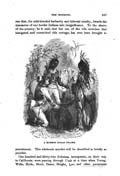
[p. 527]
one that, for cold-blooded barbarity and infernal cruelty, dwarfs the
massacres of our border Indians into insignificance. To the shame
of the country, be it said, that but one of the vile wretches that
instigated and committed this outrage, has ever been brought to
One hundred and thirty-two Arkansas immigrants, on their way
to California, were passing through Utah at a time when Young,
Wells, Hyde, Stout, Dame, Haight, Lee, and other prominent
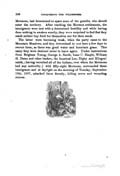
[p. 528]
Mormons, had determined to spare none of the gentiles who should
enter the territory. After reaching the Mormon settlements, the
immigrants were met with a determined hostility and while having
done nothing to awaken enmity, they were surprised to find that they
could neither buy food for themselves nor for their stock.
The latter were becoming weak, when the party came to the Mountain Meadows, and they determined to rest here a few days to recruit them, as there was good water and luxuriant grass. This camp they were destined never to leave again. Under instructions from Brigham Young, George A. Smith, Isaac C. Haight, William H. Dame and other leaders, the fanatical Lee, Higby and Klingensmith, (having recruited all of the Indians, over whom the Mormons had any authority,) with fifty-eight Mormons, surrounded these immigrants and at daylight on the morning of Tuesday, September 13th, 1857, attacked them fiercely, killing seven and wounding sixteen.
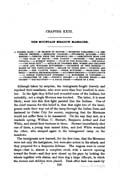
[p. 529]
CHAPTER XXIII.
THE MOUNTAIN MEADOW MASSACRE.
A DOOMED BAND—IN SEARCH OF SUCCOR—MORMONS UNMASKED— A DESPERATE DEFENSE—REPEATED CHARGES—SWARMING SAVAGES—TWO HEROS—TRIBUTE FROM THE INFAMOUS LEE—AMMUNITION RUNS LOW —THE FLAG OF TRUCE—THE PARLEY—PROMISES—THE MORMON COUNSIL—A MORMON BISHOP—PLAN OF THE MASSACRE—THE SIGNAL —"DO YOUR DUTY"—ATTACK ON UNARMED MEN,WOMEN AND CHILDREN —SICK AND THE WOUNDED BUTCHERED—INCIDENTS OF THIS HORROR— NAMES OF THE PARTICIPANTS—ESCAPE OF THREE MEN—PURSUED AND KILLED—THE CAPTIVE GIRLS—THEIR BUTCHERY—SEARCHING THE DEAD—MUTUAL RECRIMINATIONS—ACCURSED GROUND—TARDY JUSTICE —A SINGLE PARTICIPANT PUNISHED—A MURDER IN CONGRESS— —CHARACTER OF LEE—YOUNG'S INFAMY—A SELFISH BEAST—HIS COURSE—HIS GLUTTONY—A FATAL FEAST—DEATH OF A DOG
Although taken by surprise, the immigrants fought bravely and repulsed their assailants, who were more than four hundred in number. In the fight they killed and wounded some of the Indians, but unluckily, not a single Mormon was touched. The latter, it is most likely, went into this first fight painted like the Indians. One of the chief reasons for this belief is, that that night two of the immigrants made their way out of the camp through the Indian lines, and hastened to Cedar City for succor, supposing that the Mormons would not suffer them to be massacred. On the way they met, at a roadside spring, William C. Stewart, Benjamin Arthur and Joel White, and stated their business to them. Stewart immediately shot one of them, a young man named Aden, and Joel White wounded the other, who escaped again to the beleaguered camp on the meadows.
The immigrants now learned, for the first time, that the Mormons
were not only the instigators, but were also actors in the attack, and
they prepared for a desperate defense. The wagons were in corral
shape—that is, almost a complete circle with a narrow opening
toward the front—and they now closed up the gaps by locking the
wheels together with chains, and then dug a large rifle—pit, in which
the women and children were placed. Dash after dash was made by
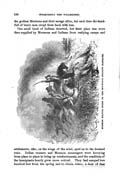
[p. 530]
the godless Mormons and their savage allies, but each time the handfull
of brave men swept them back with loss.
One small band of Indians deserted, but their place was more
than supplied by Mormons and Indians from outlying camps and
Morman Militia Going to the Mountain Meadow Massacres.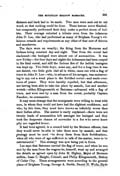
[p. 531]
distance and back had to be made. Two men were sent out to cut
wood, so that cooking could be done. These heroes never flinched,
but composedly performed their duty under a perfect storm of bullets.
Their courage extorted a tribute even from the infamous
John D. Lee, who had performed as many of Brigham Young’s
villainous errands and requirements as any other of that sect of thieves
and murderers.
The days wore on wearily; the firing from the Mormons and Indians being constant day and night. That from the corral had slackened—the besieged were almost out of ammunition. It was now Friday—for four days and nights the Arkansans had been cooped in the fatal corral, and still the furious fire of the hellish besiegers was kept up. Two little boys; some say, and for a long time it was not denied, two little girls clad all in white, came out with a flag of truce to John D. Lee—who, in advance of his savages, was endeavoring to spy out a weak place in the fortified corral—and made overtures of peace. They were harshly repelled, but that afternoon, not having been able to take the place by assault, Lee and another wretch—either Klingensmith or Bateman—advanced with a flag of truce, and were met by a man from the corral, probably Captain Fancher, its commander.
It may seem strange that the immigrants were willing to treat with men, in whom they could not have had the slightest confidence, and who, by this time, they must have known as infinitely worse than their Indian allies. The matter is easily explained—there were not twenty loads of ammunition left amongst the besieged and they took the desperate chance of surrender to a foe who never knew pity nor regarded honor.
It had been agreed, in a council held by the Mormon officers, that they would never be able to take these men by assault, and that strategy must be used "to decoy them from their fortifications, when all who were of age sufficient to talk of the matter, were to be exterminated." This strategy was now being put in force.
Lee says that Bateman carried the flag of truce, and when he was
met by the man from the wagons he, himself, went up and arranged
the details as agreed upon by John M. Higbey, Major of Mormon
militia; Isaac C. Haight, Colonel; and Philip Klingensmith, Bishop
of Cedar City. These arrangements were according to the general
plans of Brigham Young, George A. Smith, Daniel H. Wells, Hyde
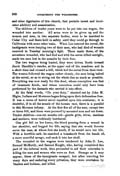
[p. 532]
and other dignitaries of this church, that permits incest and
inculcates adultery and assassination.
The children of tender years were to be put into one wagon, the wounded into another. All arms were to be given up and the women and men, in two separate bodies, were to be marched to Cedar City and there held in safety until they could go through to California with some other train. When Lee entered the corral, the immigrants were burying two of their men, who had died of wounds received in Tuesday morning’s fight. These made three, of the seventeen wounded, who had died and with the seven killed outright, made ten men lost in the assaults by their foes.
The two wagons being loaded, they were driven North toward Jacob Hamblin’s ranche, at the upper end of the meadows and in a short time had crossed a hill, which hid the corral from their view. The women followed the wagon rather closely, the men being halted at the corral, so as to string out the whole line as much as possible. Everything was now ready for this deed, whose conception was that of incarnate fiends, and whose execution could only have been performed by the dastards who carried it into effect.
At the fatal words, "Do your duty," shouted out by John M. Higbe, Indians and Mormons began firing upon their defenseless foes. It was a scene of horror never equalled upon this continent; it is doubtful, if in all the annals of the human race, there is a parallel to this Mormon infamy. At the first fire all of the men, except two or three fell, and these were pursued by mounted men and cut down. Tender children—one six months old—gentle girls, wives, maidens and mothers, were ruthlessly butchered.
One girl fell on her knees, the blood pouring from a wound in her shoulder, and begged for life, saying that she would forever serve the man, at whose feet she knelt, if he would save her life. With a horrible oath, he snatched a tomahawk from the hands of a more merciful savage, and sank it into her skull.
The wounded in the wagons were butchered by John D. Lee, Samuel McMurdy, and Samuel Knight, who, having completed this part of the infernal work, then proceeded to aid their comrades in killing the men and women who were on foot. Strange as it may appear, three of the immigrants escaped, but after traveling for many days and enduring every privation, they were overtaken by Danites and Indians, and killed.
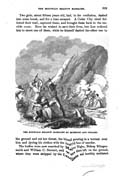
[p. 533]
Two girls, about fifteen years old, had, in the confusion, dashed
into some brush, and for a time escaped. A Cedar City chief
followed their trail, captured them, and brought them back to the
terrible scene. Here he wished to save their lives, but Lee ordered
him to shoot one of them, while he himself dashed the other one to
The Mountain Meadow Massacre By Mormons and Indians.
The bodies were now searched by major Higbe, Bishop Klingensmith
and William C. Stewart, and were then left the ground,
where they were stripped by the Indians and horribly mutilated.
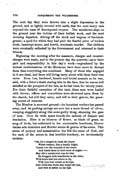
[p. 534]
The next day they were thrown into a slight depression in the
ground, and so lightly covered with earth,that the next heavy rain
exposed the mass of decomposed corpses. The murderers slept on
the ground near the victims of their hellish work, and the next
morning departed, driving off the stock and wagons of the
immigrants; a spoil for which they had paid the fearful price of broken
truth, bankrupt honor, and horrid, wholesale murder. The children
were eventually collected by the Government and returned to their
friends.
Beginning the morning after the massacre, charges and countercharges were made, and to the present day the quarrels—as to their part and responsibility in this day’s work—engendered by the mutual recriminations of the Mormons, have done more to disrupt them than everything else combined. Many of those who engaged in it are dead, and those still living carry about with them their own curse. Even Lee, hardened, fanatic and brutal assassin as he was, said, with a felon’s death staring him in the face, that he was as well satisfied at the prospect of his fate, as he had been for twenty years. For their faithful execution of this task, these men were loaded with favors; offices and concubines were showered upon them by the church, but still they carry, and will to their graves, the gnawing unrest of remorse.
The Meadow is accursed ground—its luxuriant verdure has passed away, and its gushing springs are now but a mere thread of silver, creeping sluggishly along like some guilty thing, shunning the gaze of men. Over its wide space broods the sadness of despair and desolation. Here is no blossom of flower, no blade of grass, no song of birds, but enthroned in her unutterable loneliness, Horror claims sole dominion and Murder seems fit genius of the scene. This arena of perjury and assassination has felt the curse of God, and for each of the actors in that horrible butchery, we involuntarily exclaim:
"0h, for a tongue to curse the knave Where treason, like a deadly blight, Comes o’er the councils of the brave And blasts them in their hour of might: May life’s unhallowed cup for him Be drugged with treacherles to the brim; With hopes that but allure to fly, With joys that vanish as he sips, Like Dead Sea fruits that tempt the eye, And turn to ashes on the lips.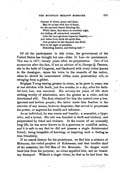
[p. 535]
Outcast of virtue, peace and tame, May he at last with lips of flame, On the parched desert thirsting die, While lakes, that shone in mockery nigh, Are fading off untouched, untasted, Like the once glorious hopes he blasted; And when from earth his spirit flies, Just prophet let the damned one dwell Full in the sight of paradise, I Beholding heaven, and feeling hell!"
Of all the participants in this crime, the government of the United States has brought but one—John D. Lee—to punishment. This was in 1877, twenty years after its perpetration. One of his accessories after the fact, if not an adviser of it, George Q. Cannon, sits in the halls of Congress, and blackened with every crime known to the decalogue, raises his voice in the councils of the nation, when he should be incarcerated within some penitentiary cell, or swinging from a gibbet.
Brigham Young waxing greater in crime, as he grew in years, was at last stricken with death, just five months, to a day, after his faithful tool, Lee, was executed. His seventy—six years of life show nothing worthy of admiration, save his genius as a ruler, and his determined will. The first obtained for him the control over a low, ignorant and lawless people; the latter made him fearless in the exercise of any means, however desperate, that served to perpetuate his power, or augment his wealth and influence.
As an individual, he was coarse and beastly; a sensualist, a hypocrite, and a tyrant. His rule was founded in theft and trickery, and perpetuated by fraud and violence. In the course of an unusually long life, he was never known to do a generous or unselfish action, and it is safe to say that he did not possess a single disinterested friend; being incapable of knowing, or inspiring such a feeling as true friendship.
If we search history for his prototypes, we find him a mixture of
Mokanna, the veiled prophet of Kohrassan, and that terrible chief
of the assassins, the Old Man of the Mountain. No danger could
bend him from his purpose; no crime appalled him, and no treachery
dismayed. Without a single virtue, he died as he had lived the
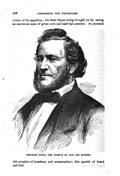
[p. 536]
victim of his appetites; his fatal illness being brought on by eating
an enormous mess of green corn and half—ripe peaches. So perished
Brigham Young, The Apostle of Lust and Murder.
this prophet of treachery and assassination; this apostle of fraud and lust.